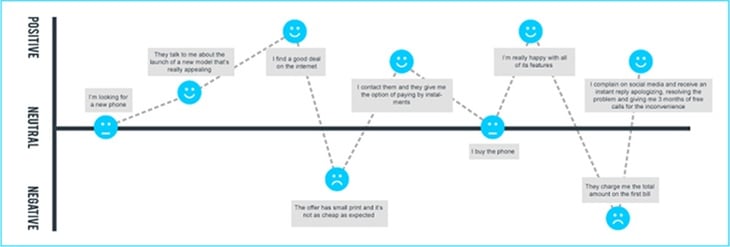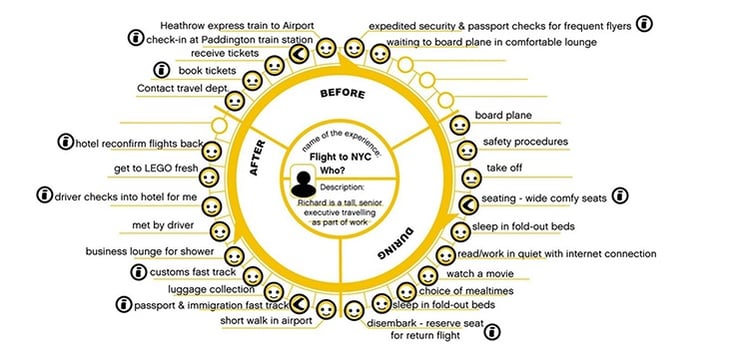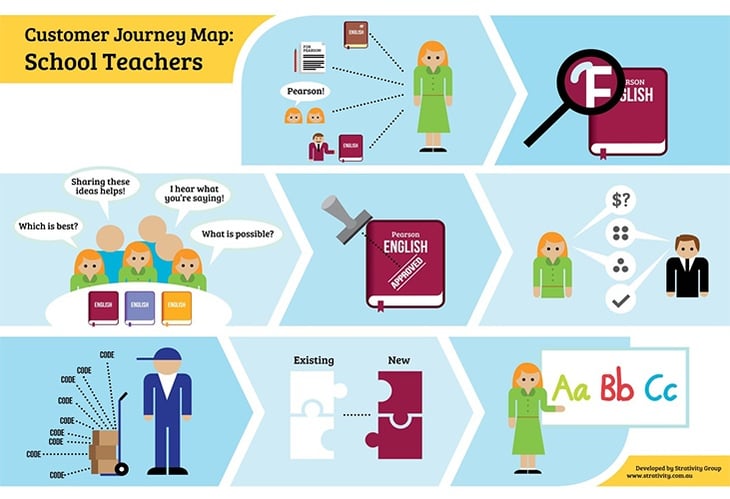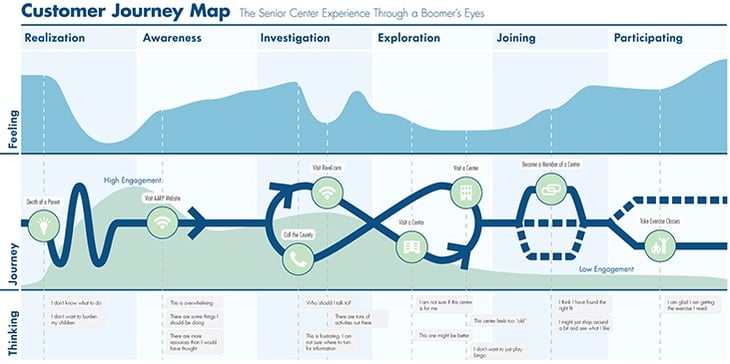Customer Journey Mapping can create real insights that will help improve your customer experience (CX), but with so many variations out there, it is hard to know which one to choose. From traditional linear or cyclical model, to illustrative and even video, each layout has unique strengths and benefits that can improve your brand's CX.
Linear
 Source: HoopTap
Source: HoopTap
A linear customer journey map is perhaps the industry standard. It simply demonstrates how one customer moves from their initial interaction with a brand to post-sales support and all the touchpoints in between.
By adding more elements, such as an emotional involvement scale, a linear customer journey map can be used as a graph, with various metrics assessing the customer emotions and involvement as they move from touchpoint to touchpoint.
Cycle (or Wheel)
 Source: Experience Matters
Source: Experience Matters
A customer journey map in the form of a cycle highlights the never-ending nature of CX optimisation. Even once a customer has ended their journey, employees need to evaluate how they can regain the customer or entice more leads by improving their CX. For this reason, a cycle or wheel is appropriate for organisations that offer long-term payments plans, such as phone contract companies, or those with a loyal customer base.
As you can see from LEGO’s “experience wheel” above, this form of customer journey mapping is easily consumed, with a concise customer persona in the centre and the use of emoticons to express the customer's feelings.
Illustrative (or storyboard)
 Source: Cargo Collective - Luke Mac
Source: Cargo Collective - Luke Mac
Arguably the most visually appealing, this form of customer journey map may be more suitable when the journey in question is more active or practical. Furthermore, an illustrative customer journey map is ideal for creative organisations with highly visual learners.
By illustrating customer personas, this form of customer journey mapping is an effective way for employees to walk the journey in the customer’s shoes. If done correctly, illustrative customer journey maps should convey the actions and emotions of their customers to represent every interaction at a more human level.
Grid
 Source: Advenio
Source: Advenio
Similar to a linear customer journey map, in that it flows in one direction, the grid provides more detail and allows you to add more layers (or rows) when new insights are generated. Alternatively, these rows could highlight the various platforms customers use in a particular interaction (e.g. website, email etc.) or perhaps the departments who are responsible (e.g. Sales, Marketing etc). With the vast amount of information on display, this may suit itself to a more analytical brain, as opposed to a creative one.
A grid can also integrate all forms of a customer journey maps into one. For example, recurring stages can have its own cycle, whilst more active stages can have illustrations. Once composed and analysed in depth, a grid provides enough detail to help improve CX in all aspects of your business.
Video
Whether using graphics, real-life or whiteboards, a video can be more engaging than static maps. Like illustrative maps, videos can effectively place employees in the shoes of their customers. By doing so, employees can truly understand every interaction the customer has with their brand - perhaps at a more personal level than other layouts mentioned.
Despite being more engaging, a video takes longer to be consumed by employees than other layouts, which can be viewed at a glance. Although all customer journey maps should be analysed in depth, the reality may be that employees can’t comprehend the benefits of improving their CX and therefore won’t dedicate much time to watch a video on it. Nethertheless, a video's ability to capture customer emotions and engage employees far outweighs these negatives.
Conclusion
As mentioned in our “5 best customer journey mapping tools” post, there is no set way to develop and present your map. As long as your map communicates the customer journey effectively by including customers’ needs, questions and feelings, the layout doesn’t really matter. Ultimately, the type of customer journey map you choose will depend on your company culture, your resources and your preferences.
Whilst you decide which layout to go for, download our introduction to customer journey mapping guide to find out more about the customer journey mapping process and how it can maximise your CX.



